Ten Apples and a Flat Sponge reports that the Thorvaldsen Museum in Copenhagen is selling reproductions of Venus with Apple and the Birth of Venus, with some artistic interpretation:
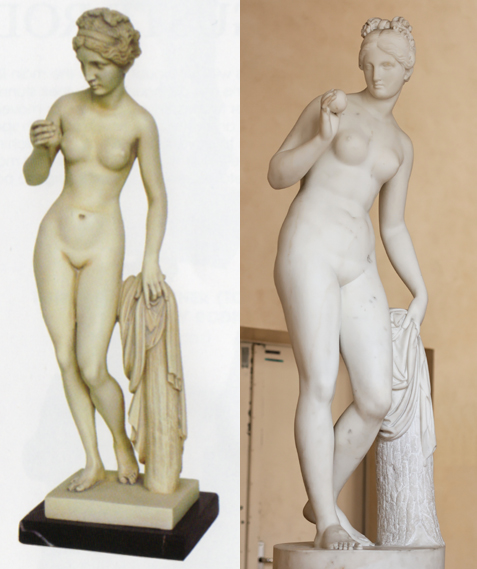
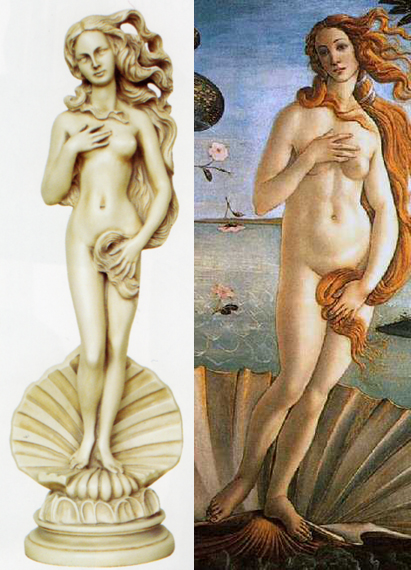
Hat tip to Shapely Prose.
Ten Apples and a Flat Sponge reports that the Thorvaldsen Museum in Copenhagen is selling reproductions of Venus with Apple and the Birth of Venus, with some artistic interpretation:


Hat tip to Shapely Prose.
Taylor D. sent in a link to a collection of vintage ads that includes this one:
From Vintage Ads:
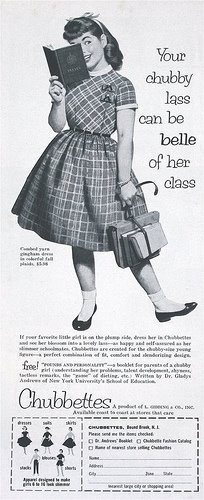
Holly M. sent us this one:
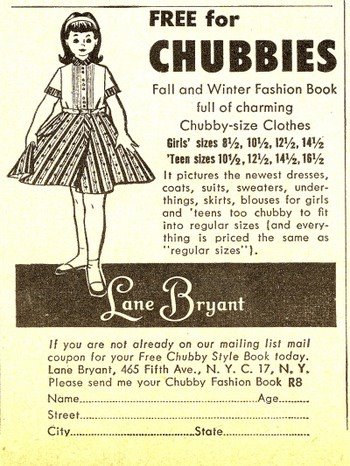
NEW! Larry Harnisch, of The Daily Mirror, sent us this one:

The fact that these girls were considered “chubby” is only slightly more distressing than the fact that polyester blends were considered fashionable.
What do they call sizes for “larger” kids these days? I know they don’t say “chubby,” but I don’t think they use the “plus-size” term for kids–am I wrong? Is there a standard industry term?
This archive of cigarette commericals, sent in by Kay W., makes some interesting comparisons of vintage and contemporary cigarette ads.
First, they compare vintage ads that try to sell cigarettes by pointing to the fact that they suppress your appetite with contemporary-ish Virginia Slims ads which seem to suggest so indirectly.
Second, they compare vintage advertisements that argue that some brands are smooth and good for your voice with the contemporary “Find Your Voice” campaign:
Third, this set of ads nicely shows how the association of glamour with cigarette smoking has transcended history:
Over at Kate Harding’s site, user Daminique writes about an ad she saw in a Dutch train station:
The idea behind this ad: the fat lady gets distracted by a bag of candy, ‘loses her head’, and people could see her PIN number because she wasn’t paying attention.
I could get really analytical here, but I run the risk of vitriolic sarcasm. I’ll just say that this ad is a great illustration of the societal connection between “health” and moral goodness, not to mention a cheap-shot joke at the expense of fat people.
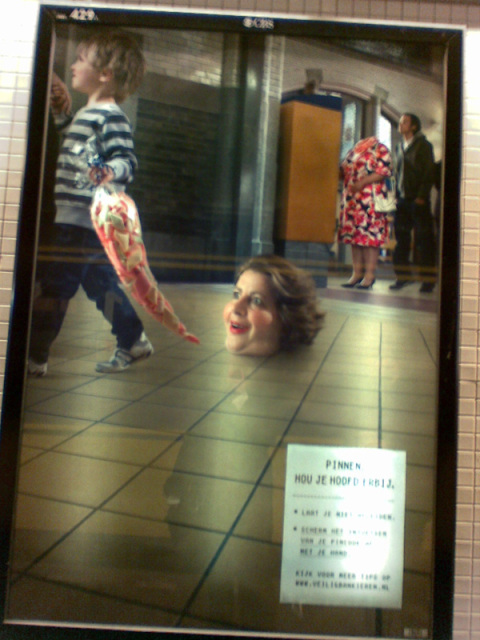
Jason S. sent us this picture of a T-shirt he saw for sale in Berkeley, California. The T-shirt says:
Wingman Services: Don’t Be Sent Out On A Dangerous SOLO Mission! Let Us BANG Her Fat Friends For You!
A “wingman” is a guy who helps his buddy get laid. Here the suggestion is that the “wingman” will take the fall and have sex with the fat one so that his buddy can have the desirable, skinny one. Notice also the violent language used to describe sex.
Nadya at Coilhouse sent in this ad campaign for Kiwi Kleen Toilet Cleaner. In order to disgust you, the ads suggest that sharing a toilet seat is like sitting directly on someone else’s ass and, to disgust you further, they suggest that that someone else could be a Mexican wrestler, a fat pig, and a transsexual. Keep it classy, Kiwi Kleen. (Images found at Coilhouse and Coloribus.)
Click here for a nice gender and race analysis of a range of Halloween costumes for adults and kids by our blogger, Wendy. We’ve also highlighted two costumes in particular: the Sexy Scholar and Anna-Rexia. And, of course, just a few days ago, we posted about the Halloween display that includes a lynched Sarah Palin and a screenshot of an Obama mask found by searching for “terrorist costume.” And don’t miss our jack-o’-lantern tribute to Max Weber. See also, if you like, my Huffington Post about the race, class, and gender politics of Halloween.
To our newest Halloween material:
Andrea G. scanned in an entire Halloween costume catalog and offers some global observations about the breadth of costumes made available. You can check out her flickr account here or scroll down for the images and some of Andrea’s commentary.
The Cover and Back:
Boys’ costumes:
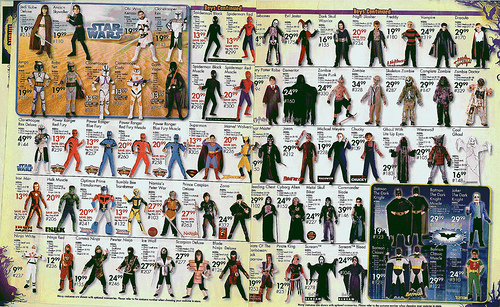
Boys’ costumes (continued) and girls’ costumes:
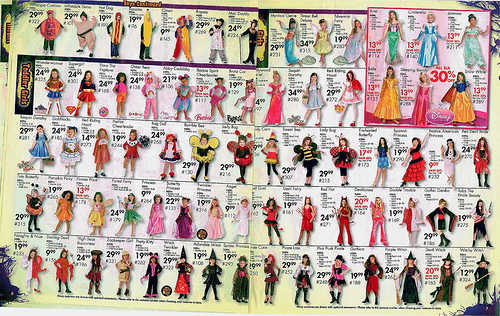
Girls’ costumes (continued):

Women’s costumes:
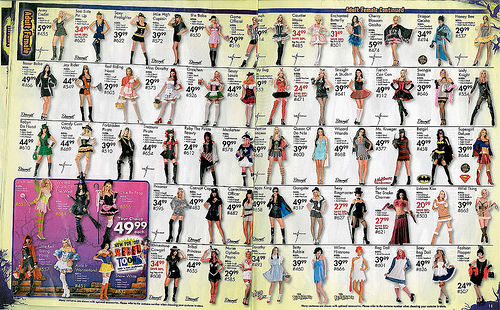
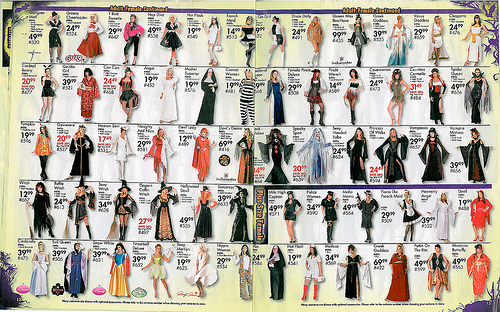
Plus women’s costumes:
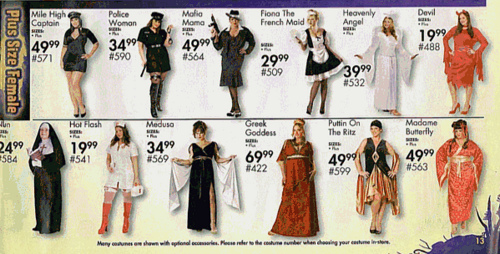
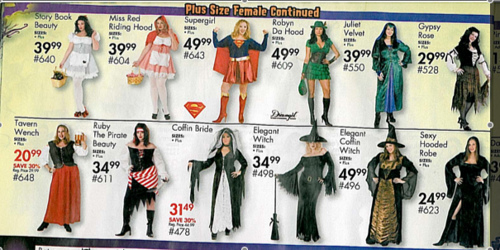
Plus women’s costumes (continued) and adult men’s costumes:
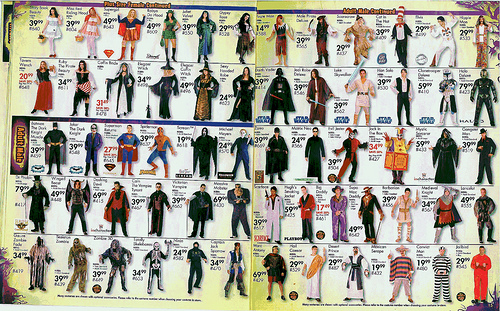
Plus men’s costumes:
First, Andrea notes how gendered the costumes are. Women overwhelmingly are supposed to look sexy, while men are supposed to look funny or scary. Note that this doesn’t vary much by age. The costumes for adults and children are strikingly similar.
Second, Andrea points to how often men’s faces are covered by masks and how infrequently women’s are. She writes that “5 out of the 198 costumes categorized under “female” or “girls” were masked (2.5%)” and “96 of the 180 costumes categorized under “male” or “boys” were masked (53.3%).” Andrea thinks: “I think this touches on the double standard American society holds for females/girls to be attractive and beautiful, while males/boys do not have to cater to this social rule, for the most part.”
Third, Andrea notes that there are costumes designed to make men look fat, but not women. For example, this “Freshman 15” costume:
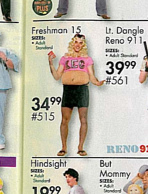
Thanks Andrea!
As Melissa at Shakesville writes:
…Subway reminds women that the only reason they have to feel good about themselves is being thin, that their self-worth is predicated on their looks, that psychological health is evidently dependent on being pretty, that fat axiomatically equals ugly, and that no man would ever love a fat girl.